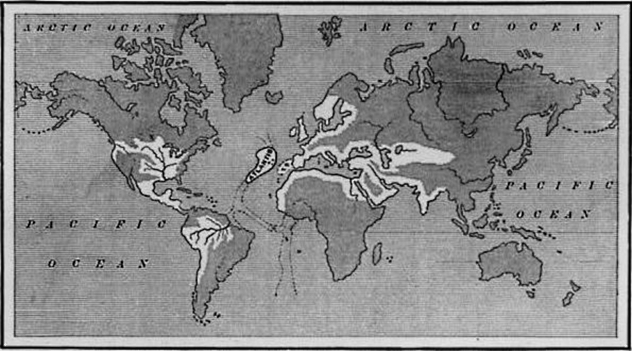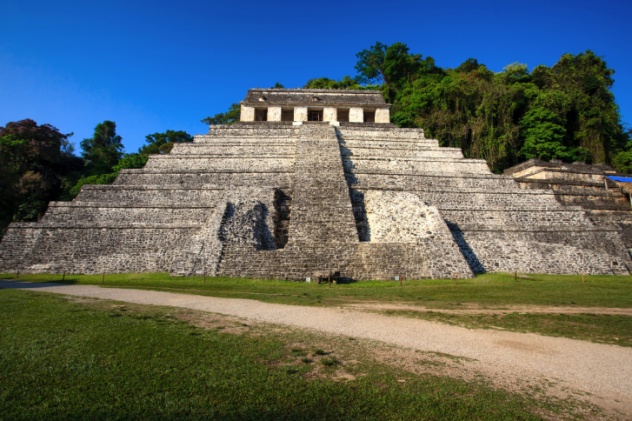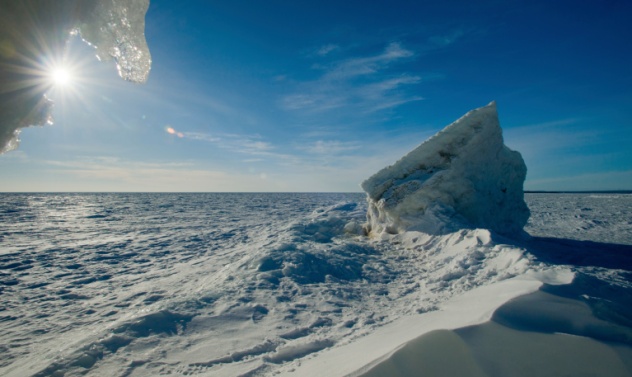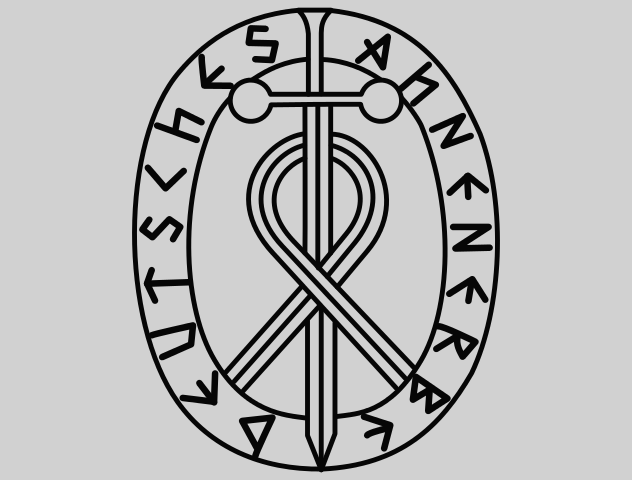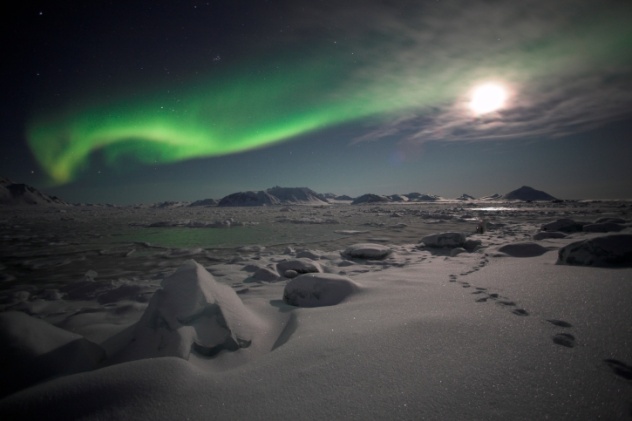10 Native Americans And Dinosaurs
Vine Deloria was born near the Pine Ridge Oglala Sioux Indian Reservation in South Dakota and grew up in a family of mixed French and Native American influence. He has written much about the necessity of restoring tribal rights and ending some of the horrific atrocities being committed against Native Americans—like the complete destruction of their culture. Aside from all the good things he’s written, he’s also the one behind the pseudohistorical book Red Earth, White Lies, which claims that the theory of humans migrating across the Bering Strait and into the Americas is absolute bunk. He claims that there’s no real evidence for the theory, and clearly, the fact that it’s stayed around for so long is simply a testament to the mental illness of the academic world. According to Deloria, absolutely everything we currently think about the world’s early history is wrong. Evolution didn’t happen, because there’s no real proof of it at all. Don’t even get him started about the ice ages, because those weren’t real, either. However, the theory that grieves him the most is the idea of people crossing the Bering Strait. It’s not only contradictory to most of the tribal lore, which tells of a history where Native Americans were born from the land they’re on, but it also gives the government grounds for declaring that Natives don’t have a right to the land, after all. The real stories are rooted in the oral histories of tribal elders. The earliest Native Americans lived alongside saber-toothed cats and mammoths, and, contrary to the idea that some species were hunted to extinction, there was a massive catastrophe that wiped them out. The Native American ancestors were created, and there was a period of peace— at about the same time they were coexisting with dinosaurs. The stories of giants roaming the Earth also explain a lot. Specifically, they indicate that there was a higher concentration of CO2 in the air. This makes accurate carbon dating all but impossible, which means that the scientifically accepted timeline is way, way wrong. All of archaeology and accepted science is wrong, actually, and all you need to do is listen to the creation myths to hear the remembered tales of fire brought by the gods and glaciers that moved across the land.
9 The Milesians
There are few areas that are still so incredibly connected with their first peoples as Ireland. It’s one of the few places that still speaks a language with old Celtic roots, after all. But there’s another theory about the first people to settle on the island: They weren’t Celts from central Europe; they were the Milesians. They’re described by A.M. Sullivan in a work dating to 1900. According to the author, the first Milesian colony originated in Asia before traveling across Europe, through Spain, and finally into Ireland. They were driven by a sacred mission, and they carried a sacred banner which bore the symbol of a dead snake and the rod of Moses. According to the story, a young prince was bitten by a poisonous snake. His father took him to Moses, who prayed over his body and healed him. It was then prophesied that the whole thing was a sign that they needed to go to a land where there were no snakes, deadly or otherwise, and that they could find the island by following the setting Sun. When they got there—three generations later—they found that Ireland was being ruled by three brothers and their dark magic. They decided that since God had indicated that they were the ones that were supposed to be living on the island, they would fight for it. They did, and they won. It’s not entirely known just where the story comes from. It’s only been recited as a part of Irish history in any sort of concrete form since the 18th century. By the mid-19th century, the story had made the jump from legend to history, as stories in Ireland are so good at doing.
8 The World’s Atlanteans
Atlantis has been tied to Crete and the Minoans. The Minoans liked bulls, and the Spanish like them, too. Clearly, Spain was settled by the survivors of Atlantis, especially considering that the bull is also a central figure in historical art of civilizations from Turkey to Babylon. According to Gavin Menzies, he’s managed to come up with all the evidence anyone could possibly need to accept that Spain’s ancestors were clearly influenced by Atlanteans—as was every other civilization that sprang up in what was once their vast empire. Once the Minoans took to the waters, it was only a matter of time before they discovered what is now Spain, and no society would be able to resist the rich, untouched lands. He also argues that they discovered more than just Spain and that Atlantis wasn’t so much a place as it was an empire. He claims to have pieced together DNA and archaeological evidence that the Atlanteans had traveled the world and had nothing short of a far-reaching, global network. It’s evidenced by such things as Minoan copper, which Menzies claims only exists in Lake Superior, tin that was clearly mined in Cornwall, the Bronze Age Nebra Disk uncovered in northern Germany, and anecdotes in the histories of the kingdoms of the Euphrates referring to the king’s fondness for Minoan pottery.
7 The Bat Creek Stone
In 1889, an archaeological dig led by the Smithsonian unearthed a strange stone from a burial mound in Tennessee. At the time, Smithsonian experts, led by Cyrus Thomas, announced that the letters carved into the stone were clearly Cherokee, and no one was really surprised by that. However, in the 1960s, someone took a picture of the stone and turned it upside down. Suddenly, the letters didn’t look Cherokee at all but more like Hebrew. Cyrus Gordon, a Semitic language scholar, confirmed that they were, in fact, Hebrew. The form of Hebrew was from the first or second century, and he translated the words to mean “for Judea.” Other scholars supported the findings, and in 1988, the stone was carbon-dated to somewhere between AD 32–769. Needless to say, the idea of Hebrew letters on a stone in Tennessee meant that people would need to take a good, hard look at the state’s history. It’s never that easy, however, as other researchers claim that the stone’s writing is Welsh. They claim that it’s the marker of the tomb of the Welsh prince Madoc, who supposedly traveled to the New World around 1170. Since that puts the stone outside of the time frame of the carbon dating, they suggest that he actually lived in 562. In 2004, American Antiquity weighed in with the opinion that the stone is obviously a forgery. They point to a Smithsonian field assistant named John Emmert as the likely forger and claim to have the source of the inscription—a Masonic text. They even suggest that papers written by Thomas seem to indicate that he knew the whole thing was a hoax. Others argue that clearly, the stone indicates that there was a Hebrew influence in early America.
6 Mayan Atlantis
While Gavin Menzies claimed that pretty much every part of the world had been touched by Atlantis, there was a group of researchers who were convinced that the origins of the Mayan civilization were with a group of refugees who fled Atlantis as it was destroyed. Charles Etienne Brasseur de Bourbourg was both a member of the clergy and one of several 19th-century adventurers and explorers who were obsessed with uncovering the secrets of ancient America. He had some good finds, too, discovering some of the few remaining copies of Mayan texts. When he translated the texts, he found a lot of talk about things like volcanoes, gods, and flying rocks. For him, it was clear that the stories set down in their creation myths were memories of where they came from—Atlantis. Other researchers claim that the whole thing is bunk and that his translations of the texts (and the basis for his theory) are very, very incorrect. That hasn’t stopped others from jumping on the same bandwagon, though. Augustus Le Plongeon, photographer and possibly something approaching an actual doctor, drew parallels to a Mayan civilization that he was convinced came from some of the Old World civilizations, including ancient India, Egypt, and Greece. He also translated texts in support of his theory, and he also translated them incorrectly. A follower of the Theosophists and Madame Blavatsky, he leaned heavily on the idea that some of the Mayan symbolism resembled that of the Kabbalah, quoting Blavatsky in support of the theory. Clearly, it was all related; the people originated in the Old World and moved out of their homeland when it was opened up and invaded by others. He and his wife also have a couple other theories. The words that Christ spoke on the cross have been incorrectly translated all along, because they weren’t translated from the Mayan language, which would have made his final words, “Now, now I am fainting. Darkness covers my face.” They also believed that the importance of the elephant in Indian culture was a clear translation of earlier worship of the mammoth.
5 The Walam Olum
In 1836, Constantine Rafinesque published The American Nations under some pretty dodgy circumstances. He claimed that the work was a complete translation of the history of the Delaware Native Americans, which he had received on a bundle of wooden plaques, given to him by a man named “Dr. Ward.” Ward was never identified, and the wooden plaques in question have never been found, either. If it sounds strangely like the claims made by Joseph Smith and his golden plates, some have speculated that’s where he got the idea from. He claimed that the plaques told the origin story of the Delaware, traveling across the Bering Strait from Asia and into the Americas around 3,600 years ago. They moved farther and farther eastward, overcoming obstacle after obstacle, coming into contact—and conflict—with other tribes, and finally settling into their home. If it sounds about right, except for the time frame, that’s because it was created to be right. It wasn’t until 1996 that the Walam Olum was finally, definitively, condemned as a hoax. For more than a century, the work was thought to have created a link between the oral tradition of the tribe and scientific history. It had detractors from the beginning, including Lucy Parks Blalock, a fluent Lenape speaker who said the translation just didn’t make sense, as well as Lenape elders who had never heard of the text or the plaques. Nevertheless, scholars took it as a real link between myth and science. On top of that, later generations latched onto the work as one of the crowning achievements of their culture. The story, though, is very similar to one that Rafinesque wrote elsewhere, in his Ancient History, or Annals of Kentucky, which outlines a group moving across the Bering Strait, fleeing an oppressive, destructive Asian empire and settling into the Delaware Bay. Also, the Walam Olum appeared not long after he submitted an essay on the Lenape language to a contest at the Royal Institute of France, and it’s suspected that his release of the supposed plaque translations had something to do with getting him noticed in the competition. Unfortunately, it also meant that for decades, false information was accepted as historical fact.
4 Solutrean Settlement Of The Americas
Part of the problem with history is that finding the first of anything can prove a little problematic. It’s long been accepted that the ancestors of the Native American tribes made their way to the Americas from Asia, but according to the Smithsonian’s Dennis Stanford and the University of Exeter’s Bruce Bradley, they weren’t the first on the continent, not by a long shot. About 10,000 years before that, Stone Age peoples from Iberia and France, the Solutreans, were crossing the Atlantic and setting up camp on the East Coast. Stanford and Bradley have archaeological proof of a connection in the form of the discovery of Stone Age tools nearly identical to Solutrean tools, unearthed in Maryland and Virginia. Flint from knives discovered back in 1971 have been found to be made from French flint, and the settlements that they came from have been dated to anywhere from 19,000–26,000 years ago. For a long time, Stanford and Bradley have been saying that they believed Stone Age Europeans crossed the Atlantic, and for a long time, their theories were brushed under the rug of mainstream history. Until the settlements were confirmed in 2012, they didn’t really have much in the way of concrete evidence, just a theory on how it could be done and a few genetic markers unique to Europeans that are found in small numbers of supposedly Asian-originated tribes. At the height of the last ice age, there were about 8 million square kilometers (3 million mi2) of ice between the west coast of Europe and the east coast of the United States. The historians argue that it’s highly possible that Stone Age explorers walked across much of the frozen Atlantic, and they had a reason for doing so. The water wasn’t frozen solid all of the time, and the part of the ocean that was water would have been an area where fish, birds, and seals gathered. Following a valuable food source could have shaped the pattern of their migration. So what happened to them, and why has it taken so long for us to find them? The numbers of people that migrated from Asia were much, much greater, and the Solutrean peoples were most likely absorbed into the larger groups. The land that they traveled to—and settled—is largely underwater now, meaning that it’s possible there’s a whole host of settlements we just haven’t found yet.
3 The Ahnenerbe, Tibet And Atlantis
The Nazi preoccupation with the occult is well documented. Himmler was attempting to prove some rather out-there theories with his establishment of the Ahnenerbe, an organization driven by the goal of not only unearthing and preserving all of the imagined ancient Aryan accomplishments, but cementing their claims to a divine heritage. Much of the organization’s work was in the department of creating evidence that would support Hitler’s claims, and the exercise was massive. From 1938–39, an SS expedition to Tibet was organized, with the partial goal of exploring the Cosmic Ice theory. Simply put, the basis of the theory is that everything was once made of ice, an idea that came to its creator in a dream. While that might not be the traditional way that scientific theories are developed, it was absolutely acceptable because it helped Himmler’s own theories about the origin of the Aryan race to make much more sense. According to his theory, Atlantis was flooded when the world’s ice melted, and those that were living there were forced to flee. Those people were, of course, the Aryan race, divine beings that had come to Earth from Heaven. From Atlantis, they headed into Central Asia, and the Ahnenerbe was going to prove that. While they obviously didn’t find traces of their divine Atlantean forebears, they did do some pretty thorough exploration of Tibet. They recorded the flora and fauna that they encountered, collected sacred scriptures, and brought back some animals that they declared to be officially Aryan, including bees and horses that they would attempt to replicate.
2 African Atlantis
On January 30, 1911, the New York Times announced that Leo Frobenius, German author and ethnologist, had discovered Atlantis. It wasn’t an island after all; it was in northwestern Africa. And, according to him, it all made sense. His evidence was in the form of some beautiful bronze sculptures and intricately created terra-cotta figures. He wrote that the figures depicted the deities of the area, and more than that, he knew that it was absolutely impossible that the locals could be responsible for creating such incredible artwork. In fact, it was a downright tragedy that they had even been tasked with the responsibility of being in the same general area as the things. He wrote, “I was moved to silent melancholy at the thought that this assembly of degenerate and feeble-minded posterity should be the legitimate guardians of so much loveliness.” If you think that’s offensive, then sit tight, because it gets worse. Frobenius created his own version of history to account for how people whom he held in such contempt ended up with such beautiful objects—objects which art historians and museum curators around the world still consider to be some of the most exquisite works of art in the world, on par with the work of the great Renaissance artists. He was certain that the artifacts were remnants of an earlier, ancient, now-extinct civilization that Mediterranean cultures remembered in the form of Atlantis. It was the only way that he thought they could have possibly existed, and he wrote that it was only logical that this cultured, creative civilization was responsible for anything good that came out of Africa.
1 Paradise Found
William Fairfield Warren’s list of credentials is disgustingly impressive. He was the president of Boston University, professor of systematic theology at the Methodist Episcopal Mission Institute at Bremen, dean of the School of Theology at Boston University . . . and so on. He also firmly believed that he knew exactly where mankind had come from—the North Pole. By the time Warren released his book Paradise Found in 1885, a lot of people had given up on finding the cradle of humanity. While people like Darwin dismissed the idea of a magical spot on the globe that all life was created from, that certainly didn’t stop Warren from trying to find it. He was trying to do more than that; he was trying to find a way to combine the theology that he believed in with the scientific evidence that he saw, and he figured that if he could find the spot where the Garden of Eden had actually been, he could do just that. The book is incredibly thorough and covers a lot of ground, citing 580 sources. Warren tied together folklore from throughout history and across the globe, cited the similarities between different mythologies, and tracked the changes that the Earth has gone through over the ages. He took Biblical accounts and descriptions of the Garden of Eden, combined them with the creation myths of the Celts and the Egyptians, and threw in the dinosaurs, the ice ages, and fossil evidence. He determined that the Garden of Eden was at the North Pole. It wasn’t just the Garden of Eden that was there, though; it was the site of Avalon, Atlantis, Hyperborea, and all of the mythical lands from all of the stories, legends, and creation myths from all the world’s cultures. The North Pole was the site of the birth of mankind, and Warren spent much of his later literary career arguing with those that said otherwise. He called the idea of an Eden in the desert unscientific and preposterous, citing the beauty that the Garden had. He also said that the Garden of Eden will never be found, except in death and through God. There’s nothing there now except for desolate, frozen wasteland that will continue to rebuff explorers and truth-seekers, who will be forced to go only one way toward the rediscovery of the cradle of humankind—through God. Read More: Twitter


